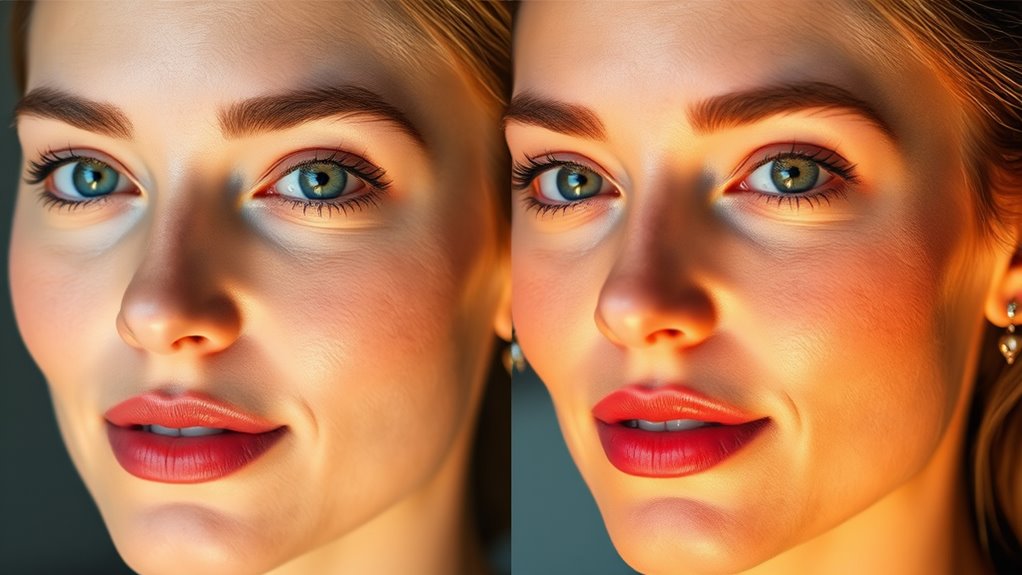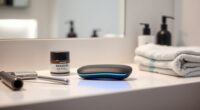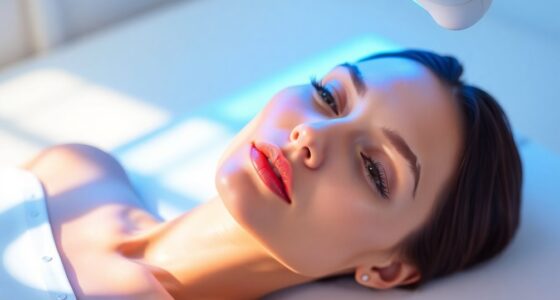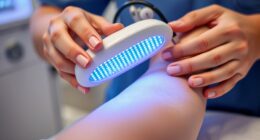If you’re choosing between HIFU and LED therapy for a non-surgical facelift, celebrities often prefer HIFU for its dramatic skin tightening and quick, noticeable results, especially around the jawline and cheeks. LED therapy is favored for gentle, ongoing skin health, reducing redness and fine lines with no downtime. Combining both offers all-encompassing anti-aging benefits. Want to see which treatment suits your goals best? Keep exploring to discover more options.
Key Takeaways
- Celebrities often prefer HIFU for quick, visible skin tightening and a non-invasive facelift effect.
- LED therapy is favored for ongoing skin health maintenance and gentle anti-aging benefits.
- Combining HIFU’s deep tissue lift with LED’s surface rejuvenation is popular among celebrities for comprehensive results.
- HIFU provides immediate, dramatic improvements; LED offers gradual, natural-looking skin enhancement.
- Both treatments are non-invasive, but HIFU is chosen for significant lifting, while LED is used for subtle, supportive care.
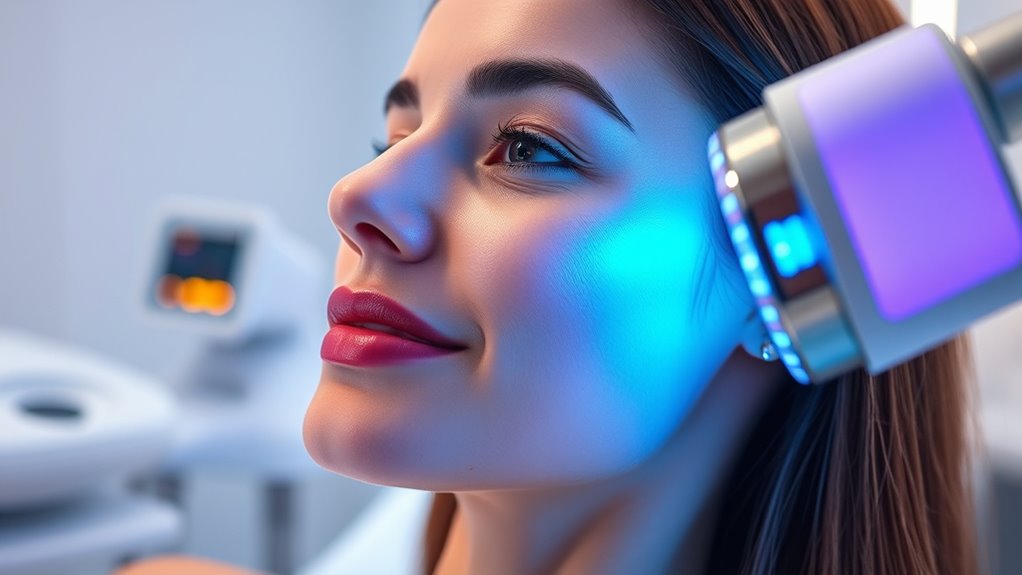
When considering non-surgical options for facelifts, HIFU (High-Intensity Focused Ultrasound) and LED therapy are two popular choices. Both treatments aim to enhance your appearance without the downtime associated with surgery, but they differ considerably in how they deliver skin tightening and anti-aging benefits. If you’re seeking a method to lift and firm your skin, understanding these differences can help you make an informed decision.
HIFU works by delivering focused ultrasound energy deep into your skin layers. This stimulates collagen production, which is essential for maintaining skin elasticity and youthful firmness. As collagen levels increase, your skin gradually tightens, reducing sagging and fine lines. This makes HIFU particularly effective for skin tightening, especially around the jawline, cheeks, and brow area. The anti-aging benefits are noticeable after a few sessions, with many users reporting a more lifted, rejuvenated appearance that lasts for months. Because HIFU targets deep tissue, it provides a more dramatic lift compared to superficial treatments.
LED therapy, on the other hand, uses specific wavelengths of light to stimulate cellular activity on your skin’s surface. It’s a gentler approach that promotes skin health and repair, leading to a softer, smoother complexion. While LED therapy isn’t as potent for skin tightening as HIFU, it excels in reducing inflammation, redness, and superficial fine lines. Its anti-aging benefits come from boosting circulation and collagen production at a superficial level, which results in a more radiant and even skin tone. LED treatments are painless, require no downtime, and can be easily incorporated into your skincare routine. They’re ideal for maintaining youthful skin and improving overall skin quality over time.
If your primary goal is considerable skin tightening and a noticeable lift, HIFU is likely the better option. It delivers a more immediate and visible improvement in skin firmness, making it popular among celebrities seeking quick, non-invasive facelift results. On the other hand, LED therapy is more suited for those who want to enhance skin health gradually, reduce early signs of aging, or maintain a youthful glow without discomfort or recovery time. Many celebrities combine these treatments, using HIFU for a strong lift and LED therapy for ongoing skin health and anti-aging benefits.
Ultimately, both HIFU and LED therapy offer valuable anti-aging benefits tailored to different needs. Your choice depends on whether you prioritize skin tightening and a noticeable lift or prefer a gentle, supportive treatment for overall skin vitality. Consulting with a skincare professional can help you determine which option aligns best with your aesthetic goals.
Frequently Asked Questions
How Long Do Results From HIFU and LED Therapy Typically Last?
Treatment longevity varies, but generally, HIFU results last about 6 to 12 months, providing noticeable skin rejuvenation. Led therapy offers more subtle, longer-lasting effects, often requiring regular sessions to maintain results. You can expect HIFU to deliver a more immediate lift, while Led therapy enhances skin health over time. To maximize skin rejuvenation, consider a personalized plan combining both treatments, and stay consistent with your skincare routine.
Are There Any Significant Side Effects for Each Treatment?
When it comes to side effects, you’ll want to weigh the risks involved carefully. HIFU may cause temporary redness, swelling, or tingling, but allergic reactions are rare if the procedure is done properly. LED therapy generally has minimal side effects, mainly mild skin irritation. However, always check with your provider about potential allergic reactions or risks, so you’re not caught off guard. Knowledge is power in making an informed decision.
Which Treatment Is More Suitable for Sensitive Skin Types?
If you have sensitive skin, LED therapy might be more suitable because it’s gentler and can be easily personalized to your skin’s needs. HIFU could cause discomfort or irritation due to its intensity. Always discuss your skin sensitivity with a skincare professional, who can tailor the treatment to minimize risks. Prioritizing treatment customization ensures you get a safe, effective non-surgical facelift that respects your skin’s unique sensitivities.
Can HIFU or LED Therapy Be Combined With Other Non-Surgical Treatments?
You can definitely combine HIFU or LED therapy with other non-surgical treatments. Multi-modal therapies are popular because they target different skin concerns simultaneously, enhancing results. Combining treatments like microdermabrasion, radiofrequency, or chemical peels with HIFU or LED can boost your skincare routine. Just consult with a specialist to create a safe, effective combination treatment plan, ensuring each modality complements the others for ideal, long-lasting results.
What Is the Average Downtime Associated With Each Procedure?
You’ll find that HIFU has minimal downtime, typically requiring just a recovery period of a few hours to a day, with little to no activity restrictions afterward. Led therapy, on the other hand, often involves no downtime at all, allowing you to resume your activities immediately. Both procedures are convenient, but HIFU might have slight recovery periods, so plan accordingly and avoid intense activity for the first 24 hours.
Conclusion
When choosing between HIFU and LED therapy for a non-surgical facelift, it’s all about your goals and preferences. Did you know that over 60% of people see noticeable improvements after just one HIFU session? Whether you want quick results or a gentle approach, both treatments have their perks. Consider what matters most to you—speed, comfort, or longevity—and pick the one that fits your lifestyle. Your radiant, youthful look is just a decision away!
